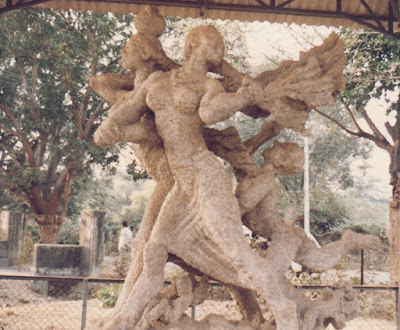http://www.bagchiblog.blogspot.com
My
junior colleagues in Kolkata had always been telling me to take a trip to their
city for a visit to Santiniketan during the Poush Mela. Poush is the 9th
month of Bengali Calendar overlapping both December and January of the
Gregorian Calendar. It is the season of harvests and farmers have enough money
to celebrate. On the last day of Poush the festival of Poush Sankranti is
celebrated. In Santiniketan. Poush Mela is a massive celebration with sweets,
several
varieties of delectable Bengali dishes, music, recitations and folk
theatre accompanied by folk music and dance.
 |
| Sculpture by Ramkinker Baij |
I could never make it to Santineketan during
the Mela. This time too my wife and I were there but only after the
celebrations were over and inmates of the place were back studying for their
examinations. But having come to Kolkata and not visiting Santiniketan would be
an affront to the Bard of Santiniketan. That is what we thought – a trifle
over-estimation of ourselves.
The
beginning of Santiniketan dates back to earlier than 1901. Tagore’s
father
Maharishi Debendra Nath Tagore had bought this piece of land from Rajbari of
Raipur for a pittance for his spiritual needs. He used to come here for
meditation and, later, others too seemed to have joined him. The building which
is reckoned as the original Santiniketan was constructed for his use.
 |
| The first building that came up in Santiniketan |
After
almost fifty years followed Patha Bhawan in 1901, which came into being as an
institution of primary education run by Rabindra Nath Tagore. It was during
this time that my maternal uncle was admitted at Patha Bhawan. Initially there
were only 5 students. Characterised by its philosophy “of learning by the heart
with closeness to nature without any superficial barrier between teachers and
students” as opposed to
the Western method of rote learning, its system of
teaching and learning was different. What
started as a school grew into the Vishwa Bharati University. It is perhaps the
only primary school that is affiliated with an University.
 |
| Uttarayan where Tagore used to reside |
While only a building was earlier known as
Santiniketan, today it is the entire complex of numerous structures is known by
that name. It comprises intellectual activities, literary and artistic efforts
as also crafts like on cloth or leather. Music is another integral part of the
education. No wonder one can often find the students go on musical soirees.
That Tagore gave birth to a distinctive genre of music universally known as
Rabindra Sangit is perhaps a very well known fact. A large number of youngsters
flock to the place only to specialize in Rabindra Sangit. They have to make
extraordinary effort to master 2000 songs that he had written, each set to a
different tune by him.
 |
| Path Bhawan (from internet) |
Apart
from music Santiniketan is known for art – visual art. From our childhood we
had seen many practitioners of art who had internalised Santineketan way of
painting so much so that a brief look at it would be enough to tell us the
provenance of the style.
All
in all, it is a great institution. It
produced different kind of men and women who were well educated, well
behaved and gentle and cultured to a fault. When they went out in to the wide
world they carried Santiniketan along with them. I remember the wife of a
faculty member from the up-country of the Indian Institute of Public
Administration who had been to Santiniketan and used to speak
flawless Bengali.
She had Santiniketan seemingly imprinted all over her.
 |
| Another scupture by Ramkinker |
As
visitors what we can do is only to see the standing structures or gawk at the
sculptures of Ramkinker Baij and collages of Nandlal Bose. I find that very
frustrating but then I cannot do anything about it. I console myself with the
thought that it is enough we have been able to visit the place and pay our
silent homage to the great polymath who preceded our generation.




No comments:
Post a Comment